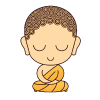7 days Buddha 25 Jan - 2 Feb b.e.2541

Sunday Buddha
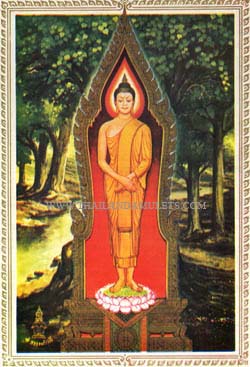
Sunday Buddha - Parng Tawained
Representing an Open-Eye posture, the Buddha stands with hands crossed over his abdomen, in pensive thought. The right hand is placed over the left on the upper thigh. Here, the enlightened Buddha contemplates his achievements and knowledge, standing still for 7 days under the Bodhi Tree to contemplate the suffering of all living things.
Sunday Buddha's mantra
U-Tay-Ta-Yan-Jak-Ku-Mar A-Ga-Ra-Cha Ha-Ris-Sa-Wan-Noh Pa-Ta-Vip-Pa-Par-Soh Tung Tung Na-Mas-Sa-Mi Ha-Ris-Sa-Wan-Nung Pa-Ta-Vip-Pa-Par-Sung Ta-Yat-Cha Kut-Ta Vi-Ha-Ray-Mu Ti-Wa-Sung Yay Phra-Ha-Ma-Na Way-Ta-Ku Sup-Pa-Dhum-May Tay May Na-Mo Tay Ja Mung Pa-La-Yan-Tu Na-Mut-Tu Put-Ta-Nung Na-Mut-Tu Poh-Thi-Ya Na-Mo Vi-Mut-Tar-Nung Na-Mo Vi-Mut-Ti-Yar E-Mung So Pa-Rid-Tung Gua-Ta-Wa Mo-Ro Ja-Ra-Thi A-Sa-Na
Monday Buddha
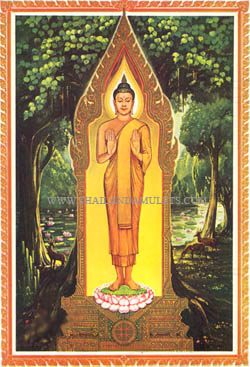
Monday Buddha - Parng Harmyart
This is a standing Buddha pose, with the left hand hanging down by the side. The right hand is raised at the chest or can be both hands, palm facing outwards, in a singe-handed gesture. This posture represents "Preventing Calamities", which is also known as "Pacifying the Relatives."
The Buddha stops the relatives from fighting or pacifying his relatives.? When the Buddha came back from Heaven, he found that his relatives were quarreling about the right to use water from a river for their rice fields. The Buddha encouraged them to compromise and said that human life is much more valuable than water and it was not worth killing men for water. Then, his relatives stopped fighting.
Monday Buddha's mantra
Yan-Tun-Ni-Mit-Tung Ar-Wa-Mung-Ka-Sun-Ja Yoh-Ja-Ma-Na-Poh Sa-Gu-Nas-Sa Sat-Toh Pa-Pak-Ka-Ho Tus-Su-Pi-Nung Ar-Gun-Tung Put-Ta-Nu-Pa-Way-Na Vi-Na-Sa-Men-Tu
Yan-Tun-Ni-Mit-Tung Ar-Wa-Mung-Ka-Sun-Ja Yoh-Ja-Ma-Na-Poh Sa-Gu-Nas-Sa Sat-Toh Pa-Pak-Ka-Ho Tus-Su-Pi-Nung Ar-Gun-Tung Dhum-Ma-Nu-Pa-Way-Na Vi-Na-Sa-Men-Tu
Yan-Tun-Ni-Mit-Tung Ar-Wa-Mung-Ka-Sun-Ja Yoh-Ja-Ma-Na-Poh Sa-Gu-Nas-Sa Sat-Toh Pa-Pak-Ka-Ho Tus-Su-Pi-Nung Ar-Gun-Tung Sunk-Kha-Nu-Pa-Way-Na Vi-Na-Sa-Men-Tu
Tuesday Buddha
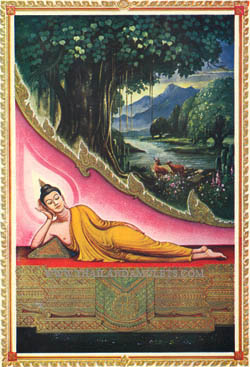
Tuesday Buddha - Parng Saiyarth
A reclining Buddha posture. The Buddha lies on his right side with his left arm draped along the body and the right arm acting as a pillow, propping up the head. One of the most dramatic and breathtaking reclining Buddha images can be found at Wat Po, Bangkok. This temple is also home to the famous Thai massage school.
The reclining Buddha represents the passage to Nirvana or a resting Buddha. The gesture represents complete peace and detachment from the world. It was believed that the Buddha entered Nirvana on this day of the week.
Tuesday Buddha's mantra
Yas-Sa-Nu-Pa-Wa-Toh Yak-Kha Nay-Wa Tas-Sen-Thi Ping-Sa-Nung Yum-Hi Jay-Wa-Nu-Yun-Chan-Toh Rut-Tin-Thi-Wa-Ma-Tun-Thi-Toh Su-Kung Su-Pa-Thi Sut-Tho Ja Pa-Pung Gun-Ji Na- Pas-Sa-Thi A-Wa-Ma0Thi-Ku-Nu-Pay-Tung Pa-Rid-Tun-Tum-Pa-Na-Ma-Say
Wednesday Buddha
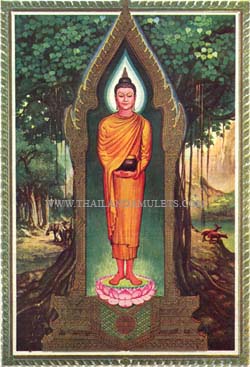
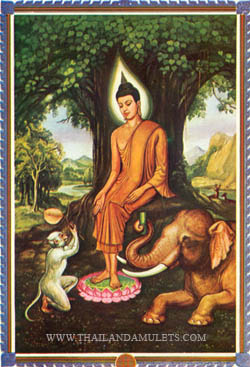
Wednesday Buddha - Parng Aumbaht / Parng Pahlaylai
There are two images that represent Wednesday, one for the morning and one for the night.
For Wednesday morning, the Buddha is standing with heels pressed together, holding an alms bowl at waist height, with both hands wrapped around it.
The Buddha holds an alms bowl. The Buddha visited his family after four years in the monastery. His father was not content when he saw the Buddha "begged" for food holding an alms bowl. Buddha explained to his father that performing pindabat, or holding an alms bow are the lineage of Buddha. Thus, the disciples can devote their food. The virtue of giving amongst Buddhists is strong until today.
Wednesday evening's pose represents the retreat to the forest, for the duration of the rainy season. It is a sitting posture with the Buddha depicted as resting with a monkey and small elephant at his side. The Buddha is about to accept a honeycomb from the monkey and a water pot from the elephant.
Wednesday Buddha's mantra
Sub-Pa-Si-Wa-Cha-Thi-Nung Tip-Pa-Mun-Tar-Ta-Kung Vi-Ya Yun-Na-Say-Thi Vi-Sunk-Koh-Rung Say-Sun-Jar-Pi Pa-Ris-Sa-Yung Ar-Nak-Ket-Tum-Hi Sub-Pa-Ta Sub-Pa-Par-Ni-Nung Sub-Pa-So-Pi Ni-Wa-Ray-Thi Pa-Rid-Tun-Tum-Pa-Na-Ma-Say
Thursday Buddha

Thursday Buddha - Parng Tassaru or Parng Samadhi
This sitting Buddha image is one of restful meditation, with legs crossed (right leg on top of the left) and both hands resting on the top, with the right hand over the left, both palms upwards. This is a classic yoga posture.
The Buddha is in meditation. This is the perfect mental discipline. The gesture is the ultimate balance of tranquility and thoughts. It is believed that the body in the position is receptive to power or energy to enter the body from the top of the head and the opening palms.
Thursday Buddha's mantra
Pu-Ren-Tum-Poh-Sum-Par-Ray Nip-Pat-Tung Mo-Ra-Yo-Ni-Yung Yay-Na Sunk-Vi-Hi-Tar-Rak-Kung Ma-Ha-Sud-Tung Wa-Nay-Ja-Ra Ji-Rus-Sung Wa-Ya-Mun-Ta-Pi Nay-Wa Suk-King-Su Kun-Hi-Tung
Friday Buddha
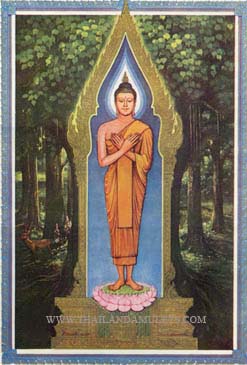
Friday Buddha - Parng Rumpueng
Friday represents "Reflection" or "Contemplation", with a standing Buddha image. Both hands are crossed at the chest (right over left), palms facing inwards. The posture depicts the Buddha standing at the Banyan Tree, wondering how he can explain the cause of suffering to his followers.
The Buddha is in contemplation of how he can teach the Dharma to others. The posture represents a complete spiritual transformation.
Friday Buddha's mantra
Aup-Pa-Sun-Nay-Hi Na-Tas-Sa Sar-Sa-Nay Sa-Dhu Sum-Ma-Tay A-Ma-Nus-Nay-Hi Jan-Tay-Hi Sa-Tar Gip-Pi-Sa-Ga-Ri-Pi Pa-Ri-Sa-Nun-Ja Tas-Sun-Nung Ma-Hing-Sa-Ya Ja-Kut-Ti-Ya Yan-Tay-Say-Hi Ma-Ha-Vi-Ro Pa-Rid-Tun-Tum-Pa-Na-Ma-Hay
Saturday Buddha
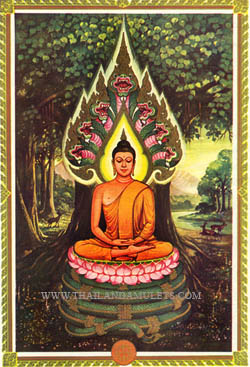
Saturday Buddha - Parng Narkprok
This dramatic statute depicts the Buddha sitting in meditation, protected by a cobra hood. The Buddha sits cross-legged in meditation, with overlapping hands, palms upwards, whilst Mucalinda, the cobra (King of Naga) spreads its hood above the Buddha's head.
The Buddha is in meditation and protected from a storm by Maculinda, the King of the Naga. The image is related to the moment when a naga spreaded its hood to protect the Buddha from a rainstorm while he was in profound meditation.
Saturday Buddha's mantra
Ya-Toh-Hung Pa-Ki-Ni A-Ri-Yar-Ya Cha-Thi-Ya Cha-Toh Na-Pi-Cha-Na-Mi Sun-Jid-Ja Par-Nung Chi-Vi-Tar Vo-Ro-Pay-Tar Ten Sud-Jay-Na So-Ta-Hi Tay Ho-Tu Kub-Pas-Sa


